The contactor-based transfer switch market is expected to grow from USD 1.3 billion in 2025 to USD 2.1 billion by 2035, registering a 5.2% CAGR and creating an absolute dollar opportunity of USD 0.8 billion. Growth is driven by rising demand for reliable power backup solutions in commercial, industrial, and utility applications. Contactor-based transfer switches are widely used for automatic switching between primary and backup power sources, ensuring minimal downtime and maintaining continuity in mission-critical operations such as hospitals, data centers, and manufacturing facilities.
Breakpoint analysis identifies critical points where market growth experiences noticeable shifts, reflecting changes in adoption patterns and external influences. In the early phase from 2025 to 2028, growth is moderate as North America and Europe lead adoption, driven by the replacement of aging manual switch systems and incremental industrial installations. Between 2029 and 2032, the market reaches a breakpoint where accelerated adoption occurs in Asia Pacific, Latin America, and the Middle East due to industrial expansion, infrastructure development, and rising awareness of power continuity requirements.
From 2033 to 2035, another breakpoint emerges as growth begins to stabilize in mature markets, with incremental revenue coming from upgrades, replacements, and adoption of smart transfer switch technologies. Overall, the USD 0.8 billion opportunity demonstrates how market expansion is punctuated by adoption milestones, technological integration, and regional shifts, providing a structured view of growth dynamics for contactor-based transfer switches between 2025 and 2035.
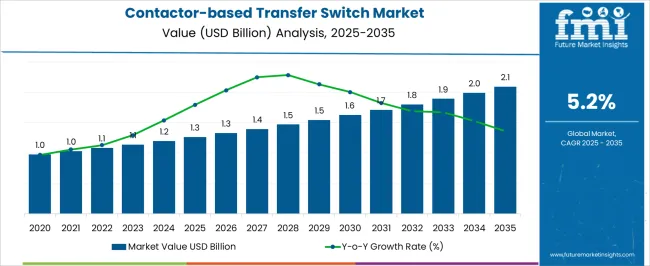
| Metric | Value |
|---|---|
| Contactor-based Transfer Switch Market Estimated Value in (2025 E) | USD 1.3 billion |
| Contactor-based Transfer Switch Market Forecast Value in (2035 F) | USD 2.1 billion |
| Forecast CAGR (2025 to 2035) | 5.2% |
The contactor-based transfer switch market is primarily driven by the industrial and commercial power sector, which accounts for around 46% of the market share, as facilities rely on automated switching to maintain uninterrupted operations and protect critical equipment. The data center and IT infrastructure segment contributes approximately 24%, using transfer switches for seamless power transition and backup management. The residential and small commercial sector represents close to 15%, where compact systems are integrated with generators for home or office backup power.
Utilities and microgrid projects account for roughly 10%, leveraging contactor-based switches for load management and energy optimization. The remaining 5% comes from hospitals, hospitality, and public infrastructure requiring reliable, automated power switching for critical services. The contactor-based transfer switch market is evolving with developments in smart controls, modular design, and enhanced safety features. IoT-enabled switches allow real-time monitoring, remote operation, and predictive maintenance to minimize downtime. Compact, energy-efficient designs simplify integration in small-scale and distributed power systems. Hybrid integration with renewable energy sources, such as solar and wind, is increasing for enhanced grid flexibility. Manufacturers are focusing on durable materials, faster switching response, and compliance with stringent safety standards.
Strategic collaborations with generator suppliers, energy management firms, and industrial clients are expanding adoption. Rising demand for reliable, automated power management in commercial, industrial, and critical infrastructure applications continues to drive market growth globally.
The Contactor Based Transfer Switch market is experiencing steady growth, driven by the increasing demand for reliable and automated power management solutions across critical infrastructure, commercial, and industrial sectors. In the current market scenario, organizations are prioritizing uninterrupted power supply and operational continuity, which has elevated the adoption of contactor-based systems. The future outlook is shaped by the growing emphasis on energy efficiency, automation, and rapid transition between power sources.
Rising investments in digital grid modernization, data centers, healthcare facilities, and industrial automation have further supported market expansion. The flexibility of contactor-based switches to integrate with both conventional and modern power distribution systems allows for scalable deployments without major hardware changes.
Additionally, the focus on safety, operational redundancy, and remote monitoring capabilities is expected to drive long-term adoption As organizations continue to seek cost-effective solutions that ensure system reliability and reduce downtime, contactor-based transfer switches are projected to remain a key component in power infrastructure, with sustained growth opportunities across multiple industries.
The contactor-based transfer switch market is segmented by operations, transition, installation, and geographic regions. By operations, contactor-based transfer switch market is divided into Automatic, Manual, Non-automatic, and By-pass isolation. In terms of transition, contactor-based transfer switch market is classified into Closed and Open. Based on installation, contactor-based transfer switch market is segmented into Critical operations power systems, Emergency systems, Legally required systems, and Optional standby systems. Regionally, the contactor-based transfer switch industry is classified into North America, Latin America, Western Europe, Eastern Europe, Balkan & Baltic Countries, Russia & Belarus, Central Asia, East Asia, South Asia & Pacific, and the Middle East & Africa.
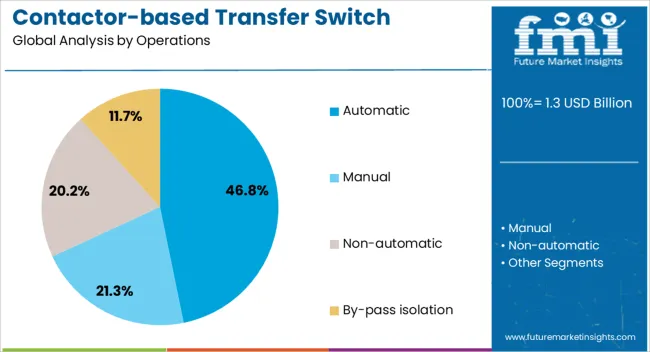
The Automatic operations type is projected to account for 46.8% of the Contactor Based Transfer Switch market revenue share in 2025, making it the leading operations segment. This dominance is being attributed to its ability to seamlessly detect power loss and initiate transfer to backup sources without human intervention. The growth of this segment has been supported by increasing reliance on critical operations power systems in hospitals, data centers, and industrial plants, where immediate power continuity is essential.
The integration of automated features reduces the risk of operational downtime and enhances system reliability, which is increasingly demanded in high-stakes environments. Additionally, automatic operations simplify maintenance and allow real-time monitoring, enabling proactive management of power distribution.
The adoption is further strengthened by the growing trend toward smart grids and energy management systems that require precise and efficient switching mechanisms As organizations prioritize operational safety, compliance, and uninterrupted service, automatic transfer switch systems are expected to continue leading the market.
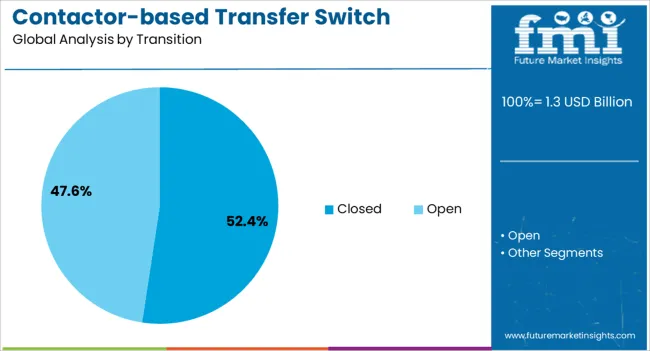
The Closed transition application segment is expected to capture 52.4% of the overall market revenue in 2025, making it the largest application type. This leading position is being driven by the need to ensure continuous power delivery while transferring between primary and backup sources without any interruption. Closed transition mechanisms are particularly valued in environments where even a momentary loss of power could disrupt operations or damage sensitive equipment.
The segment has grown due to increasing deployment in industrial automation, commercial buildings, and mission-critical facilities, where operational continuity is paramount. The design allows for smoother transitions, reducing mechanical stress and extending the lifespan of connected equipment.
Additionally, the closed transition approach provides enhanced safety and compliance with electrical standards, encouraging adoption in regulated industries With businesses and critical facilities increasingly focusing on resilience and efficiency, the demand for closed transition transfer switches is anticipated to remain strong, cementing its leadership position in the market.
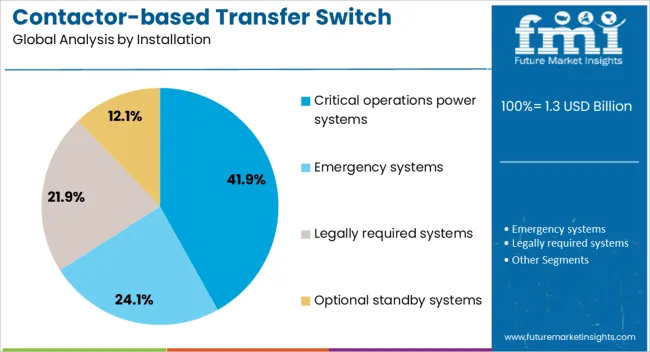
The Critical operations power systems end-use industry is projected to hold 41.9% of the Contactor Based Transfer Switch market revenue share in 2025, establishing it as the leading segment. This dominance is being attributed to the high necessity for reliable power in facilities where interruptions can result in operational, financial, or safety risks. The growth of this segment is being supported by rising deployment of transfer switches in hospitals, data centers, industrial facilities, and emergency response centers.
Critical operations require solutions that can automatically manage power transitions while minimizing downtime, a requirement efficiently fulfilled by contactor-based systems. Additionally, these systems provide enhanced durability, scalability, and ease of maintenance, which aligns with the operational priorities of high-stakes environments.
Investment in infrastructure modernization, growing regulatory emphasis on safety and reliability, and increased reliance on uninterrupted power for essential services are expected to drive adoption further. As organizations continue to strengthen operational resilience, critical operations and power systems are likely to maintain their leadership in market share and growth.
The contactor-based transfer switch market is growing due to rising demand for reliable electrical power management in industrial, commercial, and residential sectors. Asia Pacific leads with 37% adoption, driven by China (18%), India (12%), and Japan (7%). Europe contributes 30%, led by Germany (12%), France (9%), and UK (9%). North America accounts for 28%, primarily the USA, while the rest of the world represents 5%. Key applications include industrial facilities (35%), commercial buildings (30%), healthcare infrastructure (15%), data centers (10%), and residential installations (10%), reflecting diverse demand across sectors.
Market growth is fueled by increasing need for uninterrupted power supply, rising industrialization, and expanding data center infrastructure. Industrial facilities contribute 35% of adoption, commercial buildings 30%, healthcare 15%, data centers 10%, and residential 10%. Asia Pacific leads at 37%, Europe 30%, and North America 28%. High demand for automatic switching systems in manufacturing, healthcare, and IT sectors ensures operational continuity during power outages. Advancements in contactor technology enhance durability and reduce maintenance, while compliance with national safety and electrical standards drives adoption. Increasing industrial and commercial power consumption and the need for grid reliability are further accelerating market expansion globally.
Key trends include integration with smart grids, remote monitoring, and modular designs. Smart grid-compatible transfer switches are being adopted in 25% of new installations in Europe and North America. Remote monitoring systems allow predictive maintenance and reduce downtime, representing 20% of deployment. Modular and compact designs are increasingly preferred in urban infrastructure and space-constrained industrial facilities. Enhanced safety features, such as overload protection and arc flash mitigation, are incorporated in 15% of new products. Growing interest in renewable energy integration and microgrid adoption is boosting market demand, particularly in Asia Pacific and North America, where energy reliability and operational efficiency are critical.
Opportunities exist in industrial facilities, commercial buildings, healthcare centers, data centers, and residential complexes. Industrial applications account for 35% adoption, commercial 30%, healthcare 15%, data centers 10%, and residential 10%. Asia Pacific contributes 37%, Europe 30%, and North America 28%. Rapid industrial expansion, urban infrastructure projects, and new data center construction support growth. Integration with backup generators and renewable energy systems creates additional adoption opportunities. Increased awareness of uninterrupted power supply solutions among healthcare and critical infrastructure providers drives demand. Partnerships with electrical equipment manufacturers and energy service providers further strengthen market potential globally.
Challenges include high installation costs, technical complexity, and regulatory compliance. Installation expenses are 15–20% higher compared to conventional manual switches. Integration with legacy electrical systems can pose operational difficulties. Regional variations in electrical and safety regulations increase compliance complexity, particularly across Europe, North America, and Asia Pacific. Maintenance requirements for high-capacity systems and the limited availability of trained personnel constrain adoption in developing regions. Power fluctuation risks in certain areas may affect performance. Supply chain constraints for contactors, relays, and electronic components can delay deployments. Smaller residential and commercial applications often prefer simpler alternatives, limiting market penetration in price-sensitive regions.
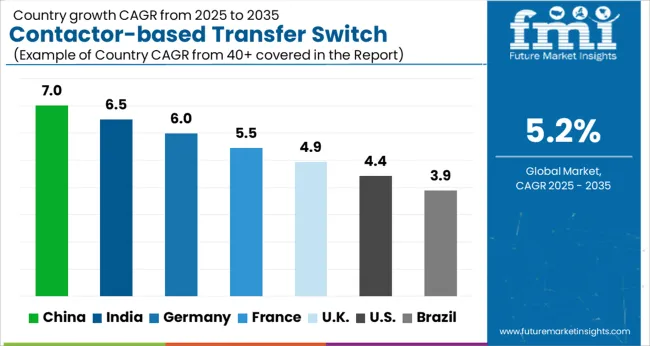
| Country | CAGR |
|---|---|
| China | 7.0% |
| India | 6.5% |
| Germany | 6.0% |
| France | 5.5% |
| UK | 4.9% |
| USA | 4.4% |
| Brazil | 3.9% |
The contactor-based transfer switch market is projected to grow at a global CAGR of 5.2% through 2035, driven by rising industrial electrification, commercial infrastructure growth, and demand for reliable power transfer solutions. China leads at 7.0%, a 1.35× multiple over the global benchmark, supported by BRICS-driven expansion in industrial facilities, urban infrastructure, and power backup installations. India follows at 6.5%, a 1.25× multiple of the global rate, reflecting growing adoption in manufacturing units, commercial buildings, and energy management systems. Germany records 6.0%, a 1.15× multiple of the benchmark, shaped by OECD-backed innovation in transfer switch technology, high-performance industrial applications, and smart power solutions. The United Kingdom posts 4.9%, 0.94× the global rate, with selective uptake in commercial and industrial facilities, retrofitting projects, and infrastructure modernization. The United States stands at 4.4%, 0.85× the benchmark, with steady adoption in utility, industrial, and commercial power backup applications. BRICS economies drive the majority of market volume, OECD nations emphasize technological efficiency and reliability, while ASEAN countries contribute through expanding industrial and commercial electrification.
The contactor-based transfer switch market in China is projected to grow at a CAGR of 7.0%, driven by rapid expansion of industrial facilities, commercial buildings, and data centers. Domestic suppliers such as CHINT Group and Delixi Electric provide high-performance contactor-based transfer switches with improved load handling and reliability. Technological developments focus on integration with smart grid systems, remote monitoring, and enhanced switching speed. Growth is further supported by government infrastructure projects and increased demand for uninterrupted power supply in industrial zones.
The contactor-based transfer switch market in India is expected to grow at a CAGR of 6.5%, supported by rising industrialization, commercial infrastructure growth, and increasing demand for reliable power backup solutions. Key suppliers such as L&T Electrical and ABB India provide switches with high load capacity, improved durability, and remote monitoring capabilities. Adoption is concentrated in industrial zones, IT parks, and commercial complexes. Technological improvements emphasize energy efficiency, fast switching, and enhanced safety features.
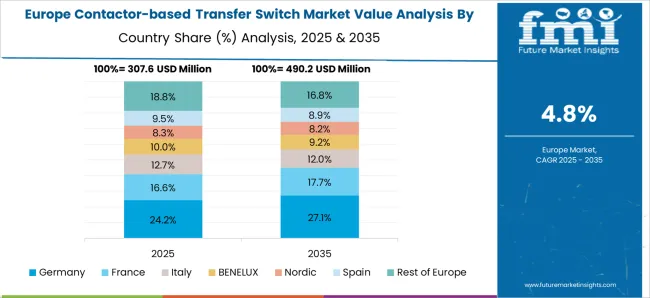
Germany’s contactor-based transfer switch market is projected to grow at a CAGR of 6.0%, influenced by industrial automation, energy efficiency regulations, and increased adoption in commercial infrastructure. Suppliers such as Siemens and Schneider Electric provide contactor-based switches with high reliability, smart monitoring features, and rapid load transfer capabilities. Demand is concentrated in manufacturing plants, renewable energy integration, and data centers. Technological focus includes smart grid compatibility, compact designs, and enhanced safety features.
The contactor-based transfer switch market in the United Kingdom is expected to grow at a CAGR of 4.9%, driven by commercial infrastructure modernization, industrial energy management, and increased deployment in data centers. Suppliers provide switches with rapid load transfer, reliability, and integration with smart energy management systems. Technological improvements focus on energy efficiency, compact design, and enhanced protection features. Adoption is concentrated in industrial facilities, commercial buildings, and mission-critical power systems.
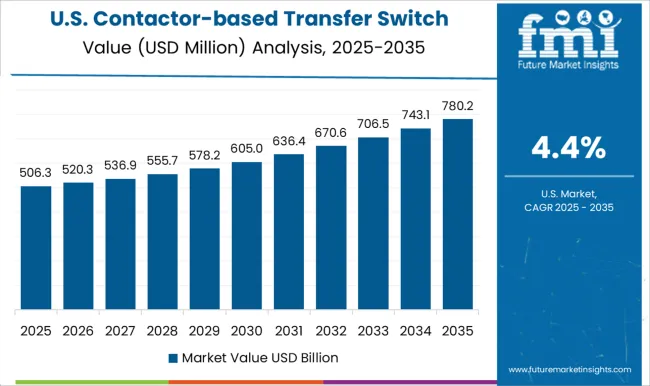
The contactor-based transfer switch market in the United States is projected to grow at a CAGR of 4.4%, supported by industrial automation, data center expansion, and commercial infrastructure growth. Major suppliers such as Eaton, ABB, and Schneider Electric provide high-performance contactor-based switches with smart monitoring, rapid transfer, and enhanced safety features. Technological developments focus on energy efficiency, reliability, and integration with automated power management systems. Adoption is concentrated in industrial, commercial, and critical infrastructure sectors.
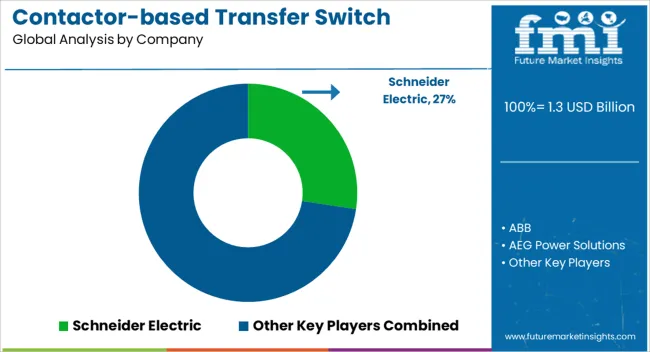
Competition in the contactor-based transfer switch market is being shaped by switching speed, reliability, and system integration for residential, commercial, and industrial power applications. Market positions are being reinforced through advanced electrical control technologies, durable components, and global service networks that ensure uninterrupted power transfer during utility outages or generator operations. Schneider Electric and ABB are being represented with high-performance contactor-based transfer switches engineered for precision, load management, and long operational life. AEG Power Solutions and Blue Square Group are being promoted with modular designs structured for scalable deployment and integration with backup power systems. Briggs & Stratton, Caterpillar, and Cummins are being applied with solutions optimized for residential, commercial, and industrial backup power scenarios. Eaton and Generac Power Systems are being showcased with units designed for high-load reliability and operational consistency. General Electric, Kohler, Midwest Electric Products, One Two Three Electric, and Peterson are being advanced with durable switches structured for diverse power environments and compliance with electrical standards. Siemens and Taylor Power Systems, along with Vertiv Group, are being represented with contactor-based switches engineered for automation, fast response, and low maintenance requirements. Strategies in the market are being centered on automation, safety compliance, and performance optimization. Research and development are being allocated to improve switching speed, load handling, remote monitoring, and interoperability with smart grid and generator systems. Product brochures are being structured with specifications covering amperage, voltage rating, switching time, enclosure type, and installation requirements. Features such as modular construction, automated operation, fault detection, and load prioritization are being emphasized to guide procurement and operational planning. Each brochure is being arranged to present technical performance, compliance certifications, and service support. Information is being provided in a clear, evaluation-ready format to assist facility managers, industrial operators, and procurement teams in selecting contactor-based transfer switches that meet reliability, efficiency, and safety requirements.
| Item | Value |
|---|---|
| Quantitative Units | USD 1.3 Billion |
| Operations | Automatic, Manual, Non-automatic, and By-pass isolation |
| Transition | Closed and Open |
| Installation | Critical operations power systems, Emergency systems, Legally required systems, and Optional standby systems |
| Regions Covered | North America, Europe, Asia-Pacific, Latin America, Middle East & Africa |
| Country Covered | United States, Canada, Germany, France, United Kingdom, China, Japan, India, Brazil, South Africa |
| Key Companies Profiled | Schneider Electric, ABB, AEG Power Solutions, Blue Square Group, Briggs & Stratton, Caterpillar, Cummins, Eaton, Generac Power Systems, General Electric, Kohler, Midwest Electric Products, One Two Three Electric, Peterson, Siemens, Taylor Power Systems, and Vertiv Group |
| Additional Attributes | Dollar sales by switch type and end use, demand dynamics across residential, commercial, and industrial power systems, regional trends in backup and emergency power adoption, innovation in reliability, load management, and automation, environmental impact of material use and disposal, and emerging use cases in microgrids and renewable integration. |
The global contactor-based transfer switch market is estimated to be valued at USD 1.3 billion in 2025.
The market size for the contactor-based transfer switch market is projected to reach USD 2.1 billion by 2035.
The contactor-based transfer switch market is expected to grow at a 5.2% CAGR between 2025 and 2035.
The key product types in contactor-based transfer switch market are automatic, manual, non-automatic and by-pass isolation.
In terms of transition, closed segment to command 52.4% share in the contactor-based transfer switch market in 2025.






Our Research Products

The "Full Research Suite" delivers actionable market intel, deep dives on markets or technologies, so clients act faster, cut risk, and unlock growth.

The Leaderboard benchmarks and ranks top vendors, classifying them as Established Leaders, Leading Challengers, or Disruptors & Challengers.

Locates where complements amplify value and substitutes erode it, forecasting net impact by horizon

We deliver granular, decision-grade intel: market sizing, 5-year forecasts, pricing, adoption, usage, revenue, and operational KPIs—plus competitor tracking, regulation, and value chains—across 60 countries broadly.

Spot the shifts before they hit your P&L. We track inflection points, adoption curves, pricing moves, and ecosystem plays to show where demand is heading, why it is changing, and what to do next across high-growth markets and disruptive tech

Real-time reads of user behavior. We track shifting priorities, perceptions of today’s and next-gen services, and provider experience, then pace how fast tech moves from trial to adoption, blending buyer, consumer, and channel inputs with social signals (#WhySwitch, #UX).

Partner with our analyst team to build a custom report designed around your business priorities. From analysing market trends to assessing competitors or crafting bespoke datasets, we tailor insights to your needs.
Supplier Intelligence
Discovery & Profiling
Capacity & Footprint
Performance & Risk
Compliance & Governance
Commercial Readiness
Who Supplies Whom
Scorecards & Shortlists
Playbooks & Docs
Category Intelligence
Definition & Scope
Demand & Use Cases
Cost Drivers
Market Structure
Supply Chain Map
Trade & Policy
Operating Norms
Deliverables
Buyer Intelligence
Account Basics
Spend & Scope
Procurement Model
Vendor Requirements
Terms & Policies
Entry Strategy
Pain Points & Triggers
Outputs
Pricing Analysis
Benchmarks
Trends
Should-Cost
Indexation
Landed Cost
Commercial Terms
Deliverables
Brand Analysis
Positioning & Value Prop
Share & Presence
Customer Evidence
Go-to-Market
Digital & Reputation
Compliance & Trust
KPIs & Gaps
Outputs
Full Research Suite comprises of:
Market outlook & trends analysis
Interviews & case studies
Strategic recommendations
Vendor profiles & capabilities analysis
5-year forecasts
8 regions and 60+ country-level data splits
Market segment data splits
12 months of continuous data updates
DELIVERED AS:
PDF EXCEL ONLINE
Transfer Paper Market Size and Share Forecast Outlook 2025 to 2035
Transfer Switch Market Size and Share Forecast Outlook 2025 to 2035
Heat Transfer Film Market Size and Share Forecast Outlook 2025 to 2035
Mass Transfer Trays Market Size and Share Forecast Outlook 2025 to 2035
Market Share Distribution Among Heat Transfer Film Manufacturers
Heat Transfer Paper Market Analysis - Growth & Demand 2024 to 2034
Human Transferrin Detection Kit Market Size and Share Forecast Outlook 2025 to 2035
Tacky Transfer Paper Market Size and Share Forecast Outlook 2025 to 2035
Fluid Transfer Solutions Market – Demand & Forecast 2024-2034
Lipid Transfer Proteins Market
Vehicle Transfer Case Market Size and Share Forecast Outlook 2025 to 2035
Textile Transfer Paper Market Size and Share Forecast Outlook 2025 to 2035
Thermal Transfer Roll Market Size and Share Forecast Outlook 2025 to 2035
Thermal Transfer Ribbon Market Growth - Demand & Forecast 2025 to 2035
Thermal Transfer Tapes Market
Adhesive Transfer Tape Market Growth, Trends, Forecast 2025 to 2035
IV Fluid Transfer Drugs Devices Market Trends – Growth & Forecast 2025 to 2035
Assessing Adhesive Transfer Tape Market Share & Industry Insights
Emergency Transfer Vacuum Mattress Market Size and Share Forecast Outlook 2025 to 2035
Non-Tacky Transfer Paper Market Size and Share Forecast Outlook 2025 to 2035

Thank you!
You will receive an email from our Business Development Manager. Please be sure to check your SPAM/JUNK folder too.
Chat With
MaRIA